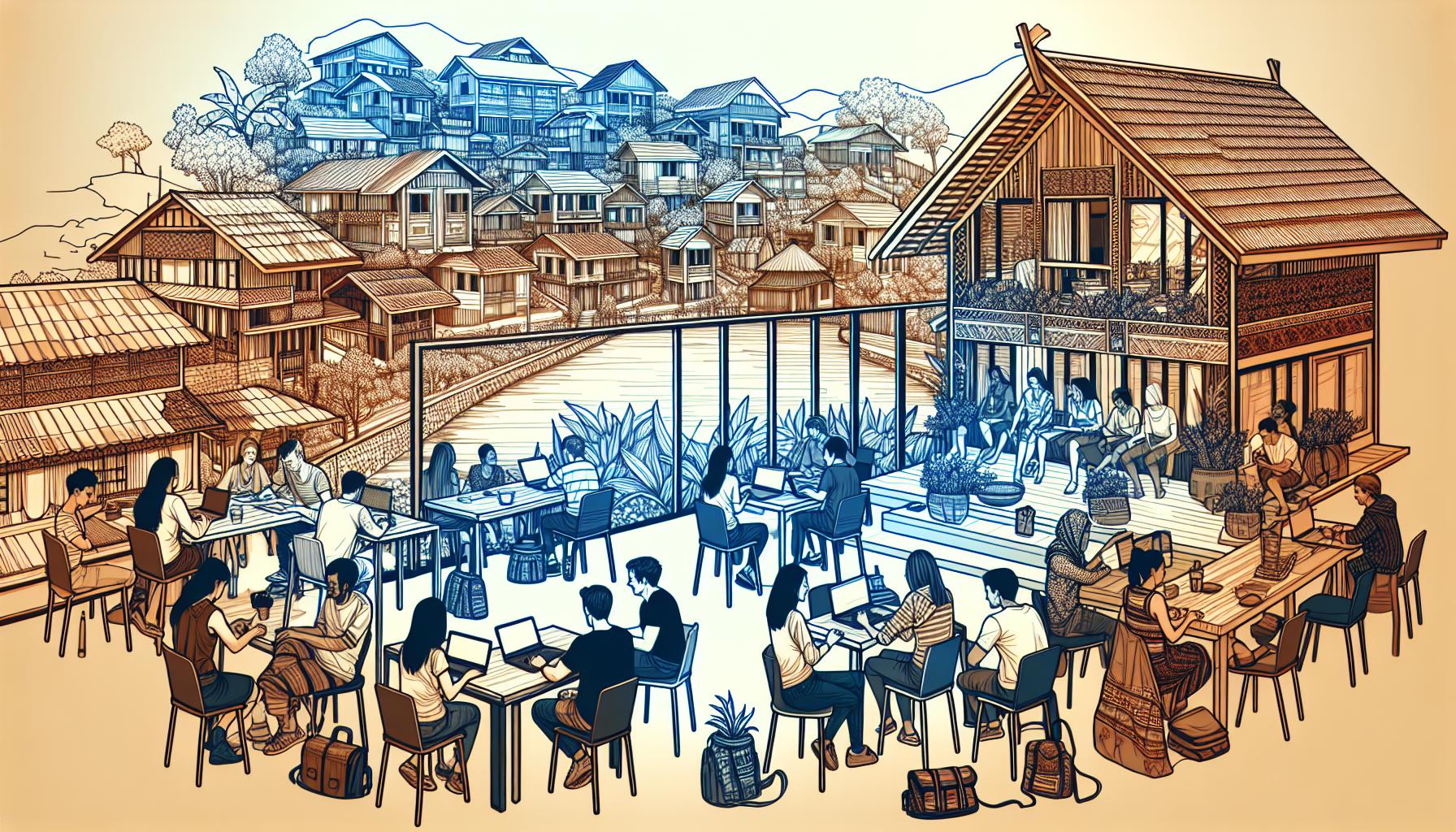In the age of remote work, digital nomad villages are rapidly becoming the next big thing. They’re sprouting up in the most picturesque corners of the world, offering a unique blend of work-life balance that traditional offices can’t compete with.
These villages, tailored for those living and working online, are more than a trend. They’re a reflection of the changing dynamics of the global workforce. With amenities designed to support productivity, community, and adventure, digital nomad villages are redefining what it means to ‘go to work.’
From Bali to Barcelona, these villages attract a new generation of workers trading in their cubicles for a laptop and a view. And it’s not hard to see why. With the promise of flexibility, freedom, and a whole new way of living, who wouldn’t want to join the digital nomad revolution?
What are Digital Nomad Villages?

Digital Nomad Villages presents a fresh concept that challenges traditional norms in today’s dynamic workspace arena. These are specially designed communities that cater to workers who’ve swapped corporate offices for the fluidity of the online world.
Geographic bounds don’t confine users of digital nomad villages – they work wherever they want, provided they have a strong internet connection. That’s the only boundary. Individuals in a digital nomad village might send emails from a sun-soaked terrace in the morning, only to join a video conference from a shared studio space in the afternoon.
This concept is more than just a fad; it responds to an increasing remote working trend. It’s a space perfectly tailored not only for productive work but also for making meaningful connections among like-minded individuals.
Benefits of Digital Nomad Villages
The remote work model, facilitated by these digital nomad villages, offers myriad benefits.
- Work-life Balance
With the blend of work-oriented and recreational amenities, digital nomad villages allow individuals to strike the perfect work-life balance. They’re getting their tasks done while also focusing on personal well-being. - Community
Living and working among people with shared experiences and values fosters a sense of community that’s often missing in traditional work settings. - Flexibility
Freedom of choice is a crucial advantage for the digital nomad. Whether it’s choosing the time to work, the place to work, or the surroundings, flexibility reigns. - Decreased Costs
Let’s not forget the economic implications. Without the office maintenance costs and daily commuting, individuals can save significantly.
The rise of these villages is a testament to the effective blend of personal and professional lives. Embracing this transformative work model is the commitment to a lifestyle, a new wave transforming the concept of “going to work.”
Popular Digital Nomad Villages around the World

Below, we’ll jump into three popular digital nomad villages rapidly garnering attention.
Madeira, Portugal
Madeira, an autonomous region of Portugal, is one island that’s caught the eye of digital nomads worldwide. Not surprisingly, the gorgeous scenery, comfortable climate, and affordable cost of living have made it a top spot.
But it’s the Digital Nomad Village in Madeira that truly stands out. This genuinely innovative concept embraces the digital nomad lifestyle wholeheartedly, offering fast internet, co-working spaces, and even a program of events to enhance the work-live-play concept. It’s a testament to Madeira’s dedication to shaping a community tailored specifically to digital nomads.
Bali, Indonesia
Bali needs little introduction. It’s a global hotspot for digital nomads, with many co-working spaces spread across the island. But not just the tropical climate and beaches draw digital nomads. Bali’s digital nomad community is internationally known.
Bali’s Ubud is renowned for its focus on wellness, with many yoga centers and vegan-friendly restaurants. Also, the cost of living is significantly affordable compared to many Western countries, allowing for a comfortable lifestyle even on a frugal budget.
Chiang Mai, Thailand
Chiang Mai, located in the mountainous region of Northern Thailand, is another favorite amongst digital nomads. It’s become one of the eminent hubs for digital workers from around the globe.
Chiang Mai’s allure stems not just from its rich culture and hospitable locals but also from its cost-effective accommodation, food, and the availability of countless co-working spaces. The city is a vibrant, thriving hub, tracing its appeal to its conscientious approach to staying ahead of digital trends.
Each of these communities tends to the needs of remote workers differently, yet all unify in their commitment to providing a conducive environment for work, leisure, and connection. They represent but a small selection of a much broader trend, painting a promising picture of the future of work.
What to Expect in Digital Nomad Villages

Three key elements can be found in many digital nomad communities worldwide: community and networking opportunities, excellent co-working spaces and facilities, and diverse accommodation options.
Community and Networking Opportunities
A significant appeal of digital nomad villages is the chance to meet like-minded people exploring a similar path. Digital nomads aren’t just freelancers or entrepreneurs – they’re also trailblazers charting a new course for work-life balance.
This has led to the organic development of strong, supportive communities in these villages. Networking events, meetups, and casual gatherings provide numerous opportunities for digital nomads to connect and collaborate. Whether seeking a project partner or a bit of professional camaraderie, it’s all readily accessible.
Co-working Spaces and Facilities
Arguing from the perspective of work, digital nomad villages have kept pace with the needs of their inhabitants. Co-working spaces are notable fixtures in these villages, providing essential amenities like high-speed internet, meeting rooms, and private workstations. Beyond these basics, many spaces stand out with additional perks like cafes, libraries, and event spaces, ensuring nomads can maintain a comfortable working environment while accessing resources and community.
For example, the digital nomad village in Chiang Mai is home to over 30 co-working spaces. Each offers a unique blend of features catering to different working styles. Meanwhile, Pulau Ubud, a popular digital village in Bali, features co-working spaces combining Balinese architecture with modern amenities, embodying the best of both worlds.
Accommodation Options
Accommodation in digital nomad villages is as diverse as those who call them home. Options range from shared houses, perfect for nomads eager for a community-oriented experience, to private apartments for those seeking more tranquility. Some villages offer unique accommodations, like bamboo bungalows in Bali or restored villas in Portugal’s Madeira. Regardless of preference, the plethora of options ensures that every digital nomad can find something that suits their needs and budget.
Pairing the charm of exotic locales with the functionality of modern workspaces, digital nomad villages are the face of a dynamic shift in the world of work and lifestyle choices. These communities embody the spirit of adaptability and freedom that only the digital age could bring to life. Regardless of where the roadmap of the future leads, it is certain that these villages – and the digital nomads in them – will continue to thrive and set new trends in the global workplace.
Things to Consider Before Choosing a Digital Nomad Village

Choosing the right digital nomad village can be a challenging job. With many options available, how does one make the right selection? The key lies in considering the primary factors influencing quality of life and productivity.
Cost of Living
One can’t discuss digital nomad villages without addressing the elephant in the room – the cost of living. Digital nomad villages vary significantly in living expenses, including rent, groceries, and utilities.
Bali and Chiang Mai are known for their affordability, with an average monthly living cost of $1,000 and $800, respectively. On the other hand, Madeira, although affordable compared to many Western cities, is on the higher end, with an average monthly cost of $1,400.
| Village | Average Monthly Cost |
|---|---|
| Bali | $1,000 |
| Chiang Mai | $800 |
| Madeira | $1,400 |
Visa Requirements
Understanding visa requirements is crucial for any digital nomad planning to set roots in a foreign locale. Take, for example, Indonesia. It boasts a social visa that lasts up to six months, making it a perfect spot for digital nomads planning a longer stay. Thailand more extended offers a special visa for digital nomads, a benefit some other countries are starting to match.
Internet Speed and Reliability
The most critical factor for many digital nomads is reliable, high-speed internet availability. Since their work relies on it, they cannot afford any sort of disruption. Chiang Mai and Bali have quickly recognized this need and are home to several co-working spaces offering speedy internet. Madeira also sets the pace through its “Digital Nomad Village” project by providing accessible, high-speed internet.
Digital nomad villages like Madeira, Bali, and Chiang Mai provide a unique blend of community, affordability, and work-life balance. They’re designed with digital nomads in mind, offering top-notch co-working spaces, diverse accommodations, and networking opportunities.
Living as a digital nomad offers unparalleled freedom and flexibility but is challenging. Exploring social connections, maintaining stability, and handling administrative tasks can be daunting. Yet, for those willing to embrace the lifestyle, the rewards are plentiful. Digital nomad villages are a testament to the evolving nature of work, a trend that will likely continue.






